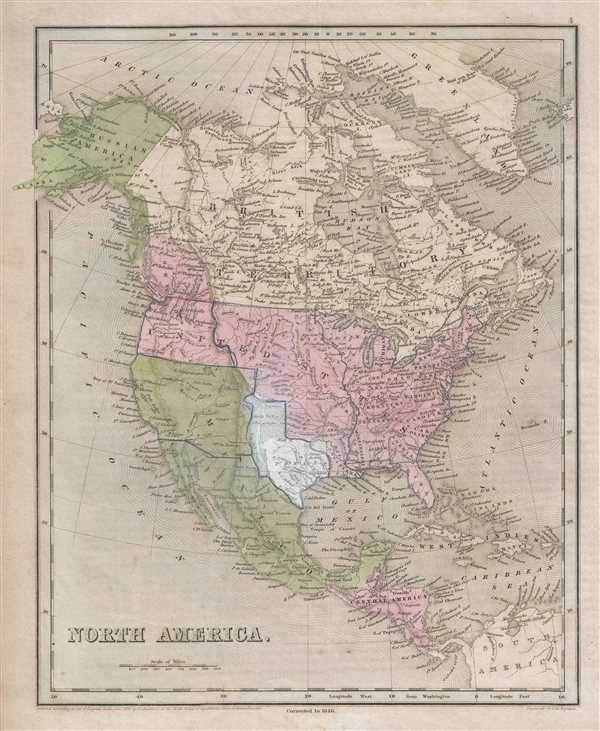This item has been sold, but you can get on the Waitlist to be notified if another example becomes available, or purchase a digital scan.
1846 Bradford Map of North America w/Republic of Texas
NorthAmerica-bradford-1846
Title
1846 (dated) 15 x 12.25 in (38.1 x 31.115 cm) 1 : 25344000
Description
Texas as a Republic and before the Compromise of 1850
The geography of Texas illustrated on this particular example of this map is unique, thanks to the previous owner's manuscript additions. Shaded in a white ink, Texas is depicted as it was after the Mexican War and prior to the Compromise of 1850. Texas claimed all land east of the Rio Grande, which extended north to modern-day Wyoming, to the U.S. border, which at that time was the Arkansas River. Texas was formally admitted to the Union in December 1845 and the Republic of Texas ceded sovereignty to the United States on February 19, 1846. The annexation of Texas led to a deterioration of foreign relations between the United States and Mexico due to an unresolved border dispute between Texas and Mexico and directly led to the Mexican-American War.
The 54°40' Dispute
The extension of the Pacific Northwest border of the United States is not depicted at the 49th parallel, which is the contemporary border between the United States and Canada, but rather at the parallel 54°40' north, which was the border with Russian America and well into modern day British Columbia. The Oregon Question was disputed for decades between the United States and Great Britain. The basis for the dispute was mostly economic. The fur trade in the Pacific Northwest at this point in history was booming, which meant that both British and American companies and citizens wanted access to this area. American interest also came back to the concept of Manifest Destiny and the Westward Expansion. Although the border was set at the 49th parallel by 1846 (as the manuscript notation in Washington State notes), the crisis was not fully resolved until 1872. A manuscript notation in red pen illustrates the U.S.-Canadian border extension along the 49th parallel and around Vancouver Island.
Other manuscript notations are illustrated here, such as the outlining of the Louisiana Purchase as well as the Mexican Cession and the Gadsden Purchase, which took place in 1853. Florida is outlined by itself, perhaps referring to the Adams-Onís Treaty, signed between the United States and Spain, which formally ceded Florida to the U.S. It is unclear why Nova Scotia and New Brunswick are outlined, as well as why each of the Great Lakes merited outlining as well. Overall, myriad locations throughout the continent are labeled. Each of the states within the United States that had been admitted by 1846 are labeled, along with state capitals and other major cities. All five of the Great Lakes are labeled, along with numerous rivers. Locations in Canada, Mexico, and Central America are also labeled. The vast majority of Alaska (labeled as Russian America) and the Yukon remain 'unexplored'.
This map was engraved by George Boynton and published by Thomas Bradford in 1846.
CartographerS
Thomas Gamaliel Bradford (1802 - 1887) was born in Boston, Massachusetts, where he worked as an assistant editor for the Encyclopedia Americana. Bradford's first major cartographic work was his revision and subsequent republishing of an important French geography by Adrian Balbi, Abrege de Geographie published in America as Atlas Designed to Illustrate the Abridgment of Universal Geography, Modern and Ancient. Afterwards Bradford revised and expanded this work into his own important contributions to American cartography, the 1838 An Illustrated Atlas Geographical, Statistical and Historical of the United States and Adjacent Countries. Bradford's cartographic work is significant as among the first to record Texas as an independent nation. In his long career as a map publisher Bradford worked with William Davis Ticknor of Boston, Freeman Hunt of New York, Charles De Silver of Philadelphia, John Hinton, George Washington Boynton, and others. We have been able to discover little of Bradford's personal life. More by this mapmaker...
George Washington Boynton (fl. c. 1830 - 1850) was a Boston based cartographer and map engraver active in the first half of the 19th century. Boynton engraved and compiled maps for numerous publishers including Thomas Bradford, Nathaniel Dearborn, Daniel Adams, and S. G. Goodrich. His most significant work is most likely his engraving of various maps for Bradford's Illustrated Atlas, Geographical, Statistical, and Historical, of the United States and the Adjacent Countries and Universal Illustrated Atlas. He also engraved for the Boston Almanac. In 1835, Boynton is listed as an employee of the Boston Bewick Company, an engraving, stereotype, and printing concern based at no. 47 Court Street, Boston. Little else is known of his life. Learn More...

